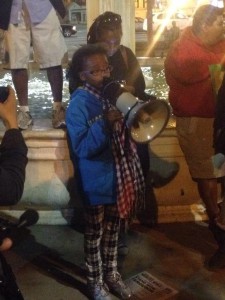
Hours prior to the grand jury announcement in Missouri, people started gathering in Leimert Park, a center of the Black community in Los Angeles and historic gathering point for actions against racism. After the announcement, the crowd swelled to hundreds expressing their anger at the non-indictment of Darren Wilson. A community speak-out began, where people voiced their distrust of the system and their experiences of being Black in the United States.
A little girl held the bullhorn and spoke into the crowd: “I’m nine years old, and I see the police all over killing us like we’re just little mice. But we are people!”
Andrew Nance, leading organizer of the ANSWER Coalition in LA, also spoke. “I know none of us here were surprised when they decided not to indict Darren Wilson; just like at this very park we weren’t surprised when they let George Zimmerman walk, or when they executed Troy Davis. It’s clear that this system isn’t going to work for us. We have to organize against the system as a whole, and fight to put a new system in it’s place.”
After the speak-out, people began marching and took the streets on MLK Jr. Boulevard. Another nearby rally converged with the march from Leimert Park to cheers, growing the crowd to around 1,000.
Marching down MLK, the action stopped at an LAPD Station, illuminated by spotlights from multiple police headquarters. The crowd chanted, “Can’t ignore us any longer, we’ll be back and we’ll be stronger!”
The march moved on weaving up and down major streets, with people in the community joining along the way, some even parking their cars and getting out to march. But nobody wanted to go back to Leimert Park—the energy was so high, everyone decided to march to the University of Southern California, about four miles away. Many students came out of their dorms to join the action.
Once the crowd reached USC after a long march, there was still the consensus that it should continue. “Turn it up, don’t turn it down, we’re doing this for Mike Brown!” rang through the streets as the march continued all the way to the LA Convention Center in Downtown Los Angeles.
There, to protect the wealthy section of Downtown LA, hundreds of riot-gear-clad cops flooded the streets, but the march was undeterred. Briefly, a section of the march ran up the side of an on-ramp onto the freeway, backing up traffic for miles.
After a standoff at the freeway on-ramp, the energy was still surging. Again, the march continued marching, now through major Downtown LA streets. At several intersections, people used trashcans and construction signs to construct barricades to impede the convoy of police vehicles following the march, forcing the police to get out and clear the street of debris at multiple corners.
The march ended at the LAPD Headquarters across from LA City Hall, arriving at about 1:30 a.m. There, demonstrators faced-off with a line of riot cops, who aggressively started pushing them back when protesters had committed no crime.
But the police assault was short-lived, as the crowd responded resolutely and forced the police to back off. In an unprecedented move, the officer in charge even announced an apology for the brief use of force, fearing the determination of the crowd.
People stayed at the LAPD headquarters until around 3 a.m., chanting and speaking out about continuing the struggle the entire time, vowing to return to Leimert Park the following day.
All in all, the march covered about 10 miles of taken-over streets, and marched for over six hours, shutting down multiple parts of the city in solidarity with the struggle in Ferguson.






